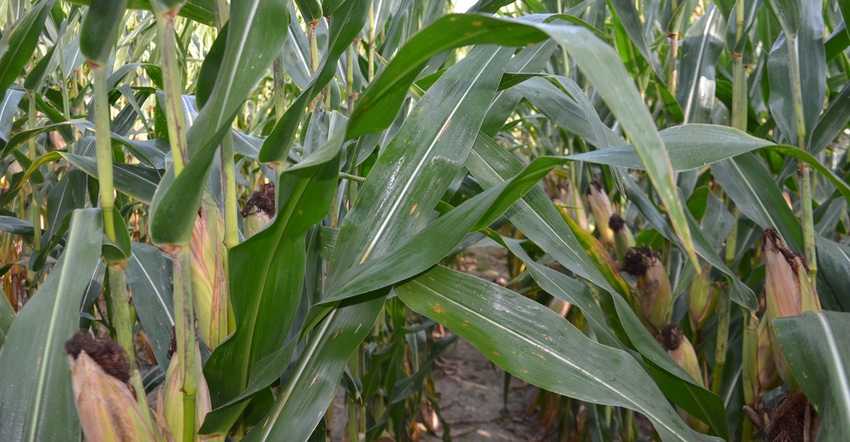September 30, 2020

Most corn reached physiological maturity, or black layer, by Sept. 15. Black layer indicates the end of dry matter accumulation in the kernels. Grain moisture varies from 32% to 35% at this point, depending on the hybrid.
Ideal moisture for grain harvest is 15% to 20% for minimal drying. However, highest yield is generally achieved when harvested at 28% moisture. After that point, yield starts declining because of field losses due to stalk lodging, ear droppage, and insect and disease damage. How does corn dry down to harvestable moisture levels after it reaches black layer?
In a typical season, grain drying in the field ranges from 0.5% to 0.8% moisture loss per day, which occurs mostly by evaporation. Even if hybrids have similar relative maturity ratings, some dry down faster than others. Hybrids susceptible to leaf diseases that kill plants prematurely and fields where foliar fungicides weren’t used will dry down faster. You typically harvest those fields earlier because they’re more susceptible to stalk and ear rots.
Hybrids that have better disease tolerance and stay-green power live longer, die later and dry more slowly. Management decisions such as planting date, plant population, nitrogen rates and use of foliar fungicides all affect rate of drydown and grain moisture at harvest.
As corn matures, moisture is lost through the cob, ear shank, exposed ear tips and husks. Hybrids with thinner cobs tend to lose moisture faster.
Drydown factors
Corn breeders must constantly compromise to find hybrids with the right combinations that will produce the highest income for growers. Several agronomic and genetic characteristics of corn hybrids affect rate of drydown. They include hybrid relative maturity, thickness of pericarp or skin of the kernel, and ear angle after maturity.
Upright ears tend to capture moisture in the husks and slow down the drying process. Droopy ears lose moisture faster than upright ears. Grain with thicker skin and higher test weight dries slower, while chaffy or light-weight grain dries faster. Number, thickness and tightness of husks can affect rate of dry down. Cob thickness, as noted earlier, and kernel depth also influence how fast grain dries. Because hybrids differ in these characteristics, they differ in rates of drydown.
Temperature, rainfall and amount of sunshine influence grain drying. Weather conditions after grain fill is over have a major effect on how fast grain will dry in the field. On average, it takes 20 to 25 heat units to dry grain in the field by 1 point. These heat units refer to units as measured with the growing degree days system.
So, there are lots of factors that influence moisture at harvest. A drier and warmer fall season that extends into late fall would allow corn to dry down best.
Nanda is director of genetics for Seed Genetics Direct, Jeffersonville, Ohio. Email [email protected] or call 317-910-9876.
About the Author(s)
You May Also Like






